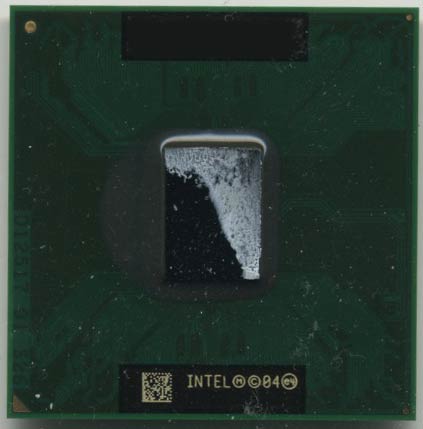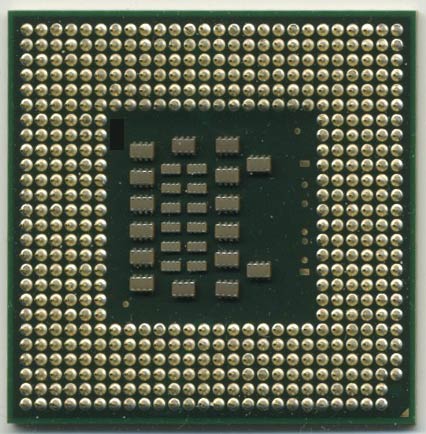Intel Yonah Performance Preview - Part I: The Exclusive First Look at Yonah
by Anand Lal Shimpi on November 30, 2005 2:50 AM EST- Posted in
- CPUs
Intel, oh Intel, how uninteresting your processors have been to us for so long now. Where have the days of the Northwood gone? Prescott brought us a minor bump in clock speed, minor increases in performance, and more importantly - major increases in power bills. But if any company can go down the wrong path for five years and still come out on top, it’s Intel. So starting next year, we’ll start seeing a new Intel. A more power conscious Intel and to kick it all off will be Intel’s first Earth-friendly dual core processor: Yonah.
As the successor to the current Pentium M (Dothan) and the predecessor to next year’s Conroe, Merom and Woodcrest cores, Yonah is a very important chip. As a mobile processor Yonah will bring dual core to thin and light notebooks, basically anywhere you’d find a Pentium M, you’ll now be able to find two Pentium Ms. The implications for mobile performance are huge, as multitasking on notebooks has rarely been all that great of an experience. At the same time, Yonah is so much more than just a dual core mobile processor - it’s a predictor of the performance of Intel’s next-generation desktop micro-architecture. Sure, it won’t have all of the architectural bells and whistles that we’ll see when Conroe debuts at the end of next year, but it’ll have many and that makes it a reference point.
The problem with the Pentium M architecture has been that although it’s traditionally done well at office tasks and obviously in the power consumption department, it has lagged behind the Pentium 4 and Athlon 64 when it comes to FP intensive applications such as video encoding, and to a lesser degree, 3D gaming. With Yonah, Intel has promised to address those performance issues, and even more so with their next-generation micro-architecture later next year. But we tend to want to see things for ourselves, and Yonah will at least give us an indication of how things have improved since Dothan, and whether or not Intel is on the right track to replacing the Pentium 4.
By now we’ve hopefully stressed the importance of Yonah, and there’s just one more detail to mention - we have one.
The Platform - Yet Another Socket
While the launch of Yonah still won’t be until January of next year, we’ve had a chip for the past month, unfortunately, we haven’t had a motherboard to stick it in. We finally got one two days ago, which is why you’re seeing this article now, instead of more pictures of our Yonah posing alongside the Xbox 360. The problem is that Intel seems to have changed sockets once more, meaning that Yonah is not backwards compatible with the original Pentium M socket.

If you’ll remember back to the introduction of the Pentium M, Intel introduced a brand new socket for the processor: Socket-479. Back then, the desktop Pentium 4 still used the pin-based Socket-478, so the different pin-out was a bit of a pain to deal with as we all wanted to be able to stick Pentium Ms in our Pentium 4 motherboards.

The Yonah socket is still a 479-pin interface, however the pin-out has been changed once more, and of course Yonah won’t even physically fit into any current Pentium M motherboards. Instead, you’ll need a brand new motherboard with a brand new chipset. So if you invested in any of the handful of desktop Pentium M motherboards that were released over the past year, you’re unfortunately out of luck.

Yonah (left) vs. Dothan (right) - Note the different pin-out
What’s this about a new chipset? Well, it’s not exactly a new chipset, rather it’s Intel’s mobile 945 chipset - the mobile version of the desktop chipset we’ve had for quite some time now. The platform we’re testing on in particular uses Intel’s 945G chipset, with integrated graphics, but of course we aren’t too interested in integrated graphics performance so we’ll be using the PCIe x16 slot on the board.
While we can’t tell you who makes the motherboard we’re testing with, the important thing to note is that it is a desktop motherboard made specifically for Yonah. It’s got a single PCIe x16 slot, meaning you don’t have to rely on integrated graphics, and all of the bells and whistles you’d expect from a desktop motherboard; this could very well be the heart of your next system.
We’ve been hearing that Pentium M based desktops will become a lot more common next year, and this motherboard is definitely an indication of that.










135 Comments
View All Comments
Furen - Wednesday, November 30, 2005 - link
Silicon on Insulator helps with current leakage, though. The problem for AMD, as I see it, is the delay of its 65nm process.forPPP - Wednesday, November 30, 2005 - link
Interpolating results shown in this article, I think we won't see Turion Dual Core with more than 2.0GHz or maybe even 1.8GHz for now, because it will consume much more power. That's why Turion will be behind it till AMD gets to 65 nm. But then Intel will have new architecture.Cygni - Wednesday, November 30, 2005 - link
Heres a quick summary of my thoughts:Best mobile proccessor option ever produced. Would be silly not to get one with your next laptop. But it doesnt have the muscle for the desktop. Nuff said.
Miggle - Wednesday, November 30, 2005 - link
gaming wise, its looks good. Altho it would be more fair to compare a 2ghz yonah to a 2ghz Athlon X2 /w 2MB L2, being within 5% of 3800+ is very good already, considering that its a notebook cpu. the desktop version may even surpass Athlon64. I sure hope AMD also has something up their sleeves. Exciting match!defter - Wednesday, November 30, 2005 - link
"Altho it would be more fair to compare a 2ghz yonah to a 2ghz Athlon X2 /w 2MB L2"Actually current comparison is fair, since Turion has only single channel memory controller. 2*512KB + dual-channel memory controller Athlon64 achieves about the same performance as 2*1MB + single-channel memory controller.
Furen - Wednesday, November 30, 2005 - link
Dual-core Turions will (supposedly) be socket S1, which will have dual-DDR2 channels.michaelpatrick33 - Wednesday, November 30, 2005 - link
How is it good to be within 5% of a 3800? The 3800+ has only 1024L2 cache total. Additionally, this is their 65nm product compared to a 90nm product and it still doesn't match it in performance? I was expecting more from Yonah than this. AMD already has dualcore notebook Turions coming in Q1 '06 so Intel does indeed look further behind.Additionally, I am not too fond of Sysmark as a performance indicator either way, but still I don't think AMD needs to run around panicing at this point.
Furen - Wednesday, November 30, 2005 - link
If the FX-60 is a 2.6GHz dual-core then AMD will have something that will more than match any Yonah thrown at it (a 2.7GHz or so Yonah could conceivably beat it, I suppose). Yonah really does make things a lot more exciting though, since at least Intel is within striking distance.anandtechrocks - Wednesday, November 30, 2005 - link
You are comparing the most powerful AMD FX processor with a mid-range mobile chip? What does this prove?tfranzese - Wednesday, November 30, 2005 - link
Considering the single core Dothan at 2.0 GHz runs about $300 I don't see how you could say that a dual-core Yonah of the same clock is 'mid-range' especially for a notebook. I highly doubt the chip previewed today will launch at or below that price point, and probably much higher.